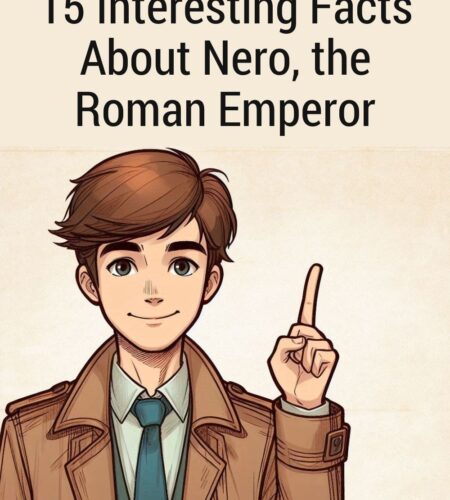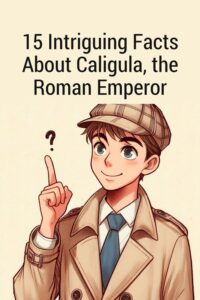Nero, the infamous Roman Emperor, is a figure who has both fascinated and horrified people for centuries. From his extravagant lifestyle to his questionable actions, Nero’s reign was marked by controversy and intrigue. In this article, we will delve into 15 captivating facts about Nero that shed light on his life and times.
Introduction
Nero, born Lucius Domitius Ahenobarbus, was the fifth Roman Emperor and ruled from 54 to 68 AD. His reign was characterized by extravagance, tyranny, and political turmoil. Let’s explore these remarkable facts in detail.
Fact 1: Nero’s Accession to the Throne
The Young Emperor: Nero became Emperor at the age of 16 after the death of his great-uncle, the Emperor Claudius. His mother, Agrippina the Younger, played a crucial role in securing his ascent to the throne.
Early Puppet Rule: Initially, Nero was heavily influenced by his advisors and tutors, particularly the philosopher Seneca, who acted as his regent. However, as he grew older, he became increasingly independent.
A Dramatic Rise: Nero’s rise to power was swift, and it marked a turning point in the Julio-Claudian dynasty.
Fact 2: The Great Fire of Rome
The Fire’s Devastation: In 64 AD, a massive fire swept through Rome, destroying a significant portion of the city. While it’s widely believed that Nero didn’t start the fire, he was accused of playing the fiddle as Rome burned, a notion that has persisted in popular culture.
Nero’s Response: Nero did provide relief to the fire’s victims and initiated urban planning improvements to prevent future fires. However, his lavish construction projects, like the Domus Aurea, further fueled rumors of his extravagance.
Blaming the Christians: To deflect blame for the fire, Nero targeted Christians as scapegoats, marking one of the earliest known persecutions of Christians in history.
Fact 3: Nero’s Extravagant Lifestyle
The Golden House: Nero’s opulent palace, the Domus Aurea or Golden House, was a symbol of his extravagance. It covered a vast area and featured luxurious decorations, including a rotating dining room.
Vast Villa in Antium: Nero also owned an extravagant villa in the coastal town of Antium (modern Anzio), which included ornate gardens and artificial lakes.
An Emperor of Excess: Nero’s lavish spending and indulgent lifestyle were a source of both fascination and disdain during his rule.
Fact 4: Nero’s Artistic Ambitions
Nero the Performer: Nero was known for his passion for the arts. He performed on stage as an actor, singer, and musician. His interest in theater led him to participate in various competitions and festivals.
The Neronian Games: Nero initiated the Neronian Games, which were artistic and athletic contests. These games included poetry readings, music, and theatrical performances.
Criticism and Ridicule: While Nero’s artistic pursuits were praised by some, others viewed them with disdain, particularly the Roman aristocracy.
Fact 5: Nero’s Love for Popularity
Nero’s Desire for Popularity: Nero was highly focused on maintaining his popularity among the Roman people. He introduced policies aimed at currying favor, including reducing taxes and implementing subsidies.
Support from the Lower Classes: Nero’s policies often appealed to the lower classes and the Roman populace, who saw him as a benevolent ruler.
Conflicts with the Senate: Nero’s popularity with the masses sometimes led to friction with the Roman Senate, who viewed him with suspicion and criticized his actions.
Fact 6: Nero’s Matricide
Murdering His Mother: One of the most shocking acts attributed to Nero was his involvement in the murder of his mother, Agrippina the Younger. Their relationship had become increasingly strained, and Agrippina plotted against her son. In response, Nero ordered her assassination.
A Twisted Mother-Son Relationship: The complex and tumultuous relationship between Nero and Agrippina has been the subject of numerous historical accounts and fictional works.
The Decline of Family Values: Nero’s actions further damaged his reputation and the image of the Julio-Claudian dynasty.
Fact 7: The Pisonian Conspiracy
Conspiracy Against Nero: In 65 AD, the Pisonian conspiracy, led by Gaius Calpurnius Piso, sought to overthrow Nero. The conspiracy involved several senators, who aimed to replace Nero with a more suitable ruler.
Suppression and Punishment: The conspiracy was uncovered, leading to a wave of arrests and executions. Many of those involved, including Seneca, Nero’s former tutor, were forced to take their own lives.
Repercussions on Roman Society: The Pisonian conspiracy revealed the growing discontent with Nero’s rule and the dangers of speaking out against the emperor.
Fact 8: Nero’s Endless Pursuit of Glory
The Colossus of Nero: Nero’s grand ambitions included a colossal statue of himself known as the Colossus of Nero, which was inspired by the Colossus of Rhodes. While the statue was never completed, the project underscored Nero’s obsession with leaving a lasting legacy.
Golden Coins and Inscriptions: Nero’s efforts to immortalize himself extended to the minting of “golden coins” bearing his image and inscriptions glorifying his reign.
A Divisive Legacy: Nero’s preoccupation with his own glory often overshadowed the practical needs of the empire, contributing to his eventual downfall.
Fact 9: The Revolt of Vindex
Galba’s Revolt: In 68 AD, Gaius Julius Vindex, the governor of Gallia Lugdunensis, led a revolt against Nero. He was supported by the governor of Hispania Tarraconensis, Servius Sulpicius Galba.
A Catalyst for Nero’s Demise: The revolt marked a critical turning point in Nero’s reign, as it signaled growing opposition within the provinces and among the Roman legions.
The Beginning of the Year of the Four Emperors: Nero’s downfall initiated the Year of the Four Emperors, a period of civil wars and political turmoil in Rome.
Fact 10: Nero’s Death
Facing Rebellion and Abandonment: As the rebellion against him spread, Nero faced the reality of losing support from the Praetorian Guard, the Senate, and the Roman people.
Fleeing Rome: With his power waning and fearing a gruesome end, Nero decided to flee Rome. He hid in a villa outside the city.
Nero’s Suicide: Realizing that he had no way out, Nero ended his life by ordering his secretary, Epaphroditos, to assist him in taking his own life. He died by suicide on June 9, 68 AD.
Fact 11: Nero’s Legacy
Mixed Historical Interpretation: Nero’s legacy is a subject of ongoing debate among historians. Some view him as a tyrant and a megalomaniac, while others argue that he was a victim of political intrigue and character assassination.
Damaging the Julio-Claudian Dynasty: Nero’s rule was a contributing factor to the Julio-Claudian dynasty’s decline. The chaos and instability that followed his death marked the beginning of a new era in Roman history.
Cultural Contributions: Despite the controversies surrounding his reign, Nero did make contributions to Roman culture and the arts, particularly in the realm of theater and performance.
Fact 12: Nero’s Portrayal in Popular Culture
Fascination in Fiction: Nero’s life and reign have been a popular subject in literature, film, and television. Various works have depicted his extravagance, cruelty, and eccentricities.
Quo Vadis: Henryk Sienkiewicz’s novel “Quo Vadis” and the film adaptations have featured Nero as a central character, emphasizing his role in early Christian persecution.
A Complex Figure: Nero’s portrayal in popular culture reflects the complexity and notoriety of his historical persona.
Fact 13: Nero’s Sucessors
Year of the Four Emperors: Following Nero’s death, the Roman Empire witnessed a rapid succession of emperors. Galba, Otho, Vitellius, and Vespasian all briefly held the title of emperor during this turbulent period.
Vespasian’s Rise: Vespasian, who emerged victorious from the Year of the Four Emperors, founded the Flavian dynasty and restored stability to the Roman Empire.
End of the Julio-Claudian Line: Nero’s death marked the end of the Julio-Claudian dynasty, which had begun with the reign of Augustus.
Fact 14: Nero’s Architecture and Urban Planning
Nero’s Architectural Projects: Despite his notoriety, Nero was involved in several architectural projects, including the Domus Aurea, a grand villa with innovative and extravagant features.
The Golden House’s Influence: The Domus Aurea had a profound impact on Roman architecture, influencing subsequent designs and features in Roman homes and palaces.
A Visionary in Urban Planning: Nero’s ideas in urban planning and the Domus Aurea’s impact on Roman architecture are often overlooked aspects of his reign.
Fact 15: Nero’s Cultural Legacy
Nero as a Patron of the Arts: Despite his personal controversies, Nero did contribute to the flourishing of the arts in ancient Rome. He sponsored poets, playwrights, and musicians, leaving a cultural legacy that outlasted his rule.
Nero’s Influence on Roman Music: Nero’s passion for music and theater helped shape the development of Roman music, influencing its composition and performance.
A Complex Figure in History: Nero’s legacy is marked by contradictions, from his tyranny to his artistic contributions, making him a complex and enigmatic figure in the annals of Roman history.
Conclusion
Nero’s reign as the Roman Emperor was marked by extravagance, controversy, and the pursuit of personal glory. Whether it was his lavish lifestyle, artistic ambitions, or the scandals that surrounded him, Nero remains a compelling figure in history. His actions and legacy have left an indelible mark on the study of Roman history and continue to intrigue those who seek to understand the complex nature of his rule.
Subscribe to our email newsletter to get the latest posts delivered right to your email.





Comments